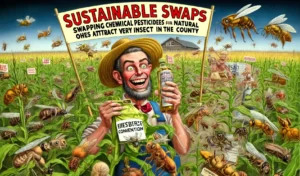
Amazon Prime free for farmers A vivid and detailed close up illustration of a West Texas farmer on a tractor receiving a package from a UPS or FedEx delivery person. The scene cap 1.webp.jpeg
The Amazonian Agrarian Advancement: Can Farmers Harvest Free Prime Benefits?
Exploring the Impact of Amazon Prime on Rural Communities
Is Amazon Prime free for farmers? Well, if you consider the hours spent chasing runaway chickens, wrangling stubborn goats, and negotiating with temperamental weather, then sure, it’s practically a gift from the heavens. But alas, despite their tireless toil, farmers still have to fork over their hard-earned cash for that coveted Prime membership. Who knew that even in the digital age, the only thing truly free for farmers is the endless supply of fresh air and questionable farmyard odors? – B.S. Slinger (Dung Slinger Farms)
The Rural Revolution: How Amazon Prime is Transforming Farming Practices

In the heart of America’s heartland, where fields stretch as far as the eye can see and the only traffic jam is caused by a herd of cattle crossing the road, a quiet revolution is underway. It’s not the kind of revolution marked by protests or political upheaval, but rather by the gentle hum of delivery drones and the click of a mouse. Yes, we’re talking about the infiltration of Amazon Prime into the world of farming – a phenomenon that’s raising eyebrows and prompting questions about the future of agriculture in the digital age.
1. The Rise of Prime in Rural America
In recent years, Amazon Prime has become a household name, offering everything from groceries to gadgets with the promise of lightning-fast delivery. But what happens when this convenience-driven service sets its sights on rural communities? According to recent reports, the results are nothing short of transformative. Farmers, once reliant on local suppliers and long drives into town, are now tapping into the power of Prime to access a wide range of goods without ever leaving the comfort of their own fields.
2. Convenience Comes to the Countryside

For farmers accustomed to the rhythms of nature and the unpredictability of weather, the arrival of Amazon Prime represents a seismic shift in how they operate. No longer do they need to plan their shopping trips around harvest schedules or wait weeks for essential equipment to arrive. With Prime’s two-day shipping guarantee, they can order everything from tractor parts to chicken feed with just a few clicks, freeing up valuable time and resources for more pressing tasks.
3. From Farm to Front Door: The Logistics of Rural Delivery
Of course, the question on everyone’s mind is: How exactly does Amazon manage to deliver packages to the most remote corners of the country? The answer lies in a combination of cutting-edge technology and old-fashioned ingenuity. Delivery drones, equipped with GPS tracking and obstacle avoidance systems, are able to navigate even the most challenging terrain, ensuring that no farmer is left waiting for their next shipment. And for those areas where drones can’t reach, Amazon’s network of delivery drivers is on hand to make sure that every package reaches its destination on time.
4. The Impact on Traditional Farming Practices
But while the convenience of Amazon Prime is undeniable, some critics worry about the long-term impact on traditional farming practices. With the rise of online shopping, are we in danger of losing the personal connections and local economies that have sustained rural communities for generations? It’s a valid concern, and one that’s worth exploring as Prime continues to expand its reach into the countryside.
5. The Digital Divide: Access and Equity in Rural America

Another issue that’s come to the forefront with the arrival of Amazon Prime in rural areas is the digital divide. While many farmers have embraced technology as a means of improving efficiency and productivity, others have been left behind due to lack of access or expertise. Without reliable internet connections or the necessary digital skills, these farmers risk being left out of the Prime revolution, further widening the gap between rural and urban communities.
6. The Future of Farming: Finding Balance in a Digital World
So where do we go from here? As Amazon Prime continues to reshape the landscape of rural America, it’s clear that finding a balance between tradition and innovation will be key to ensuring the long-term sustainability of farming communities. Whether it’s through investing in infrastructure to improve internet access or supporting local businesses in the face of online competition, there are no easy answers. But one thing is certain – the days of the lone farmer toiling away in isolation are long gone. In today’s interconnected world, even the most remote corners of the country are just a click away.
7. The Rural Retail Renaissance

With Amazon Prime, rural areas are experiencing a retail renaissance like never before. It’s as if Main Street has been replaced by a virtual shopping strip, with farmers browsing aisles of goods from the comfort of their own tractors.
8. The Prime Paradox: Saving Time or Succumbing to Consumerism?
While Prime undoubtedly saves farmers time and effort, some wonder if it’s also fueling a culture of consumerism. Are farmers really in need of same-day delivery for their pitchforks, or are they just victims of the convenience trap?
9. The Curious Case of Prime Day Deals in the Cornfields
Prime Day, Amazon’s annual sales extravaganza, has become a cause for celebration in rural communities. It’s like Black Friday, but with fewer crowds and more cows – a win-win for bargain hunters and bovines alike.
10. Conclusion: Embracing Change in the Countryside

In the end, the arrival of Amazon Prime in rural America represents not just a logistical triumph, but a cultural shift with far-reaching implications. It’s a reminder that in today’s fast-paced world, innovation knows no bounds – not even the vast expanses of the American heartland. And while the future of farming may look different than it did in years past, one thing remains constant: the resilience and adaptability of those who work the land. So here’s to the farmers – may your fields be fertile, your harvests bountiful, and your Prime memberships ever free.
Disclaimer:
In the spirit of journalistic integrity, it’s important to note that the views expressed in this article are those of the author and do not necessarily reflect the opinions of Amazon or its affiliates. Additionally, while every effort has been made to provide accurate information, readers are encouraged to conduct their own research and form their own conclusions. After all, when it comes to the intersection of technology and agriculture, the possibilities are as endless as the fields themselves.
Originally posted 2018-10-31 16:05:44.
Originally Published at FarmerCowboy.com
2025-01-06 11:46:11
Karl Hoffman is a distinguished agriculturalist with over four decades of experience in sustainable farming practices. He holds a Ph.D. in Agronomy from Cornell University and has made significant contributions as a professor at Iowa State University. Hoffman’s groundbreaking research on integrated pest management and soil health has revolutionized modern agriculture. As a respected farm journalist, his column “Field Notes with Karl Hoffman” and his blog “The Modern Farmer” provide insightful, practical advice to a global audience. Hoffman’s work with the USDA and the United Nations FAO has enhanced food security worldwide. His awards include the USDA’s Distinguished Service Award and the World Food Prize, reflecting his profound impact on agriculture and sustainability.



